|
|
|
Sort Order |
|
|
|
Items / Page
|
|
|
|
|
|
|
| Srl | Item |
| 1 |
ID:
113009
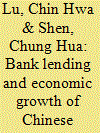

|
|
|
|
|
| Publication |
2012.
|
| Summary/Abstract |
Using a city-level dataset over the period 2004-2006, the present study investigates the relationship between bank lending and the economic growth of Chinese cities. Unlike past studies, we divide bank lending into loans from three types of banks: foreign banks, city banks and other banks. Our findings are threefold. First, the lending of foreign banks exhibits a strong and positive association with the economic growth of Chinese cities. Second, foreign direct investment in the sampled cities enhances the lending effects of foreign banks, but reduces the lending effects of other banks on the economy of Chinese cities. Third, the effects of city competitiveness are similar to those of foreign direct investment; that is, city competitiveness augments the lending effects of foreign banks but reduces the lending effects of other banks.
|
|
|
|
|
|
|
|
|
|
|
|
|
|
|
|
| 2 |
ID:
085912
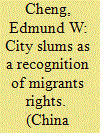

|
|
|
|
|
| Publication |
2008.
|
| Summary/Abstract |
Qin Hui, an influential public intellectual and historian from Tsinghua University, proposes allowing the formation of slums(pinmin ku) to accommodate the millions of migrants in Chinese cities.
|
|
|
|
|
|
|
|
|
|
|
|
|
|
|
|
| 3 |
ID:
176686
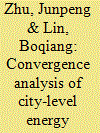

|
|
|
|
|
| Summary/Abstract |
Understanding the convergence patterns of energy intensity and the drivers leading to the club convergence are of great significance for local governments to implement targeted policies to improve energy efficiency. With this in mind, we begin with the collection of energy consumption data of 193 Chinese cities at prefecture level or above, then we adopt the log t-test and clustering algorithm to investigate convergence characteristics of energy intensity. Besides, the Ordered Probit model is adopted to investigate the drivers that affect the formulation of convergent club. We identify four convergent clubs among total 193 cities, and these clubs show great differences in energy intensity. Marketization degree, population density, foreign direct investment, resource endowment, and industrial structure are recognized as the drivers of the formation of convergence clubs. This paper adds more evidence to understand the energy intensity gap, we propose that upgrading the industrial structure, exerting economic assemble advantage, enhancing the level of opening up, and improving the marketization level are favorable measures to reduce energy intensity.
|
|
|
|
|
|
|
|
|
|
|
|
|
|
|
|
| 4 |
ID:
150890
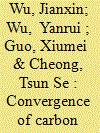

|
|
|
|
|
| Summary/Abstract |
This paper investigates the spatial dynamics of per capita carbon dioxide (CO2) emissions in China. The analyses are conducted by employing a continuous dynamic distribution approach and panel data of 286 cities at the prefecture and above-prefecture level. The results show that per capita CO2 emissions tend to converge during the sample period of 2002–2011. However, multimodality is found in the ergodic distribution of the full sample. It is also found that there is more persistence in cities with low per capita CO2 emissions, and more mobility in cities with high per capita CO2 emissions. The analyses also show that the dynamics of per capita CO2 emissions are significantly different among various geographical, income and environmental policy groups. The conditional distribution analyses indicate that multimodality cannot be explained independently by any one of the two factors, namely geographical location or income level. The findings in this study may have important policy implications for CO2 abatement in China.
|
|
|
|
|
|
|
|
|
|
|
|
|
|
|
|
| 5 |
ID:
147444


|
|
|
|
|
| Summary/Abstract |
This paper derives a NEG-style model that outlines several spatial spillover channels and examines the effects of proximities to spatially distributed factor supply and market demand on Chinese urban economies. A panel dataset of 283 prefecture or higher-level cities from 2003–2013 is used for the empirical analysis. The estimation shows that proximities to government expenditure on science and technology, to professionals in science and technology, and to the domestic and foreign markets all contribute to urban manufacturing growth, while concentrations of specialized labor force and producer services in neighboring cities have negative effects. The spatial effects of factor proximities and market potentials differ in China's three regions. Surprisingly, cities in the central region have the most significant gain from spillovers of factor supply, and cities in the eastern and western regions benefit substantially from the domestic and foreign markets. Policy implications are derived from the findings.
|
|
|
|
|
|
|
|
|
|
|
|
|
|
|
|
| 6 |
ID:
167888
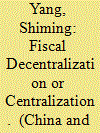

|
|
|
|
|
| Summary/Abstract |
If fiscal decentralization promotes growth, why do some regions decentralize more than others? This article identifies the growing divergence of fiscal centralization among Chinese cities and explains it in a public finance framework. It argues that fiscal decentralization and its economy‐liberalizing effect entail significant short‐term fiscal risk. The more a locality relies on uncompetitive business ownership for fiscal revenue, the less likely fiscal decentralization is to occur. This article compiles a dataset of 20 provincial capitals between 1999 and 2016 to test for the connection between a city's tax base and its fiscal centralization level. It then pairs two “most similar” cities to trace how fiscal security concerns drove their fiscal and economic policies apart. This article adds a micro‐level perspective to the literature on fiscal federalism. By pointing out the fiscal constraints confronting local governments, it offers a new angle to understand the different growth paths of Chinese cities.
|
|
|
|
|
|
|
|
|
|
|
|
|
|
|
|
| 7 |
ID:
086324


|
|
|
|
|
| Publication |
2009.
|
| Summary/Abstract |
Based on interviews conducted in four major Chinese cities, this paper examines the determinants of lending by state-owned commercial banks (SOCBs) to manufacturing firms in China. The conventional relationship banking and transaction lending theories helps explain at least part of the lender-borrower relationship in China. The perceived lending bias against non-state-owned enterprises could actually be reconciled as rational decision-making by SOCBs, partly due to the higher risk involved and/or high transaction costs in the risk evaluation of such lending. The existence of unofficial lending criteria at SOCBs nonetheless provides golden rent-seeking opportunities for unscrupulous bankers to exploit the regulatory loopholes for financial gain.
|
|
|
|
|
|
|
|
|
|
|
|
|
|
|
|
| 8 |
ID:
147414


|
|
|
|
|
| Summary/Abstract |
Using a panel of Chinese cities over the period 1991–2010, we examine the determinants of economic growth, focusing on the role of foreign direct investment (FDI) and human capital. Consistent with the predictions of a human capital-augmented Solow model, we find that the growth rate (along the path to the steady-state income level) of per capita GDP is negatively correlated with population growth rate and positively correlated with investment rate in physical capital and human capital. We find that FDI has a positive effect on the per capita GDP growth rate and this effect is intensified by the human capital endowment of the city. The latter suggests that one way that human capital contributes to growth is to serve as a facilitator for technology transfers stemming from FDI. Furthermore, we find some suggestive evidence that the FDI-human capital complementary effect is stronger for technology-intensive FDI than for labor-intensive FDI. Our results are robust to alternative measures of human capital, model specifications, and estimation methods.
|
|
|
|
|
|
|
|
|
|
|
|
|
|
|
|
| 9 |
ID:
193730


|
|
|
|
|
| Summary/Abstract |
Governments worldwide have placed much effort into improving energy efficiency to realize energy conservation and carbon emission reduction. However, households' investment in energy-efficient products seems not as positive as expected, resulting in the energy efficiency gap. The phenomenon concerning Chinese households and its underlying causes have been overlooked to a considerable extent within the extant literature. The present study endeavours to elucidate the role of present bias in shaping people's energy efficiency investment behaviour. To this end, an online survey containing a sample of more than 3000 individuals residing in Shanghai and Beijing, China was conducted. It is found that: (1) Evidence shows that about one-third of the respondent are present-biased consumers according to the results of survey-elicited time preferences. (2) All else being equal, those showing present bias are significantly underinvesting in energy-efficient appliances. This is reflected in lower adoption rates of energy-efficient electric heaters, water heaters, and washing machines. (3) Present-biased energy consumers exhibit an attention deficit regarding the energy costs of home appliances and may also encounter higher energy bills. (4) Those with signs of being sophisticated, namely, self-aware of the bias, may improve energy-related decisions, thereby mitigating the behavioral failures. This paper underscores the need to aid individuals in recognizing and addressing the present bias when promoting energy-efficiency products.
|
|
|
|
|
|
|
|
|
|
|
|
|
|
|
|
| 10 |
ID:
102447
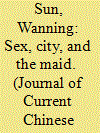

|
|
|
|
|
| Publication |
2010.
|
| Summary/Abstract |
Of the many rural migrant workers who go to Chinese cities as cheap labourers, the one who interacts most intimately with urban residents is the domestic servant. In fact, precisely because of this "intimate stranger" status, the figure of the "maid" has captured the imagination of the urban population. This fascination is evidenced by the plethora of television narratives centring on the fraught relationships between the rural migrant woman and her male employer. This paper analyses a range of television narratives from the genres of dramas and documentaries. It shows that in these narratives, sex functions as the metaphor of social inequality between two social groups. It shows that if we explore how love, romance and marriage are constructed, we may gain some insight into processes of social and ideological contestation in the domain of cultural production.
|
|
|
|
|
|
|
|
|
|
|
|
|
|
|
|
| 11 |
ID:
085905


|
|
|
|
|
| Publication |
2008.
|
| Summary/Abstract |
Since the 1950s, Shangai has undergone major changes, reflected in the practice of urban planning, which has been influenced by different Western theories.Strategic and collaborative currents as well as the concept of sustainable developement have helped reformulate urban planning styles.Does this renewal mean the emergence of an original model of Chinese urban planning,notably with the concept of harmonious urbanisation?
|
|
|
|
|
|
|
|
|
|
|
|
|
|
|
|
| 12 |
ID:
118686


|
|
|
|
|
| Publication |
2013.
|
| Summary/Abstract |
The aim of this article is to describe the various actors who intervene in the renovation (and therefore relocation) projects that have been proliferating in Chinese cities for several years. The term "relocation" is a translation of the French term "délogement," which was coined by the author to refer to the specific process that brings together urban renovation, destruction of housing, and displacement of occupants in China today. Based on a field study conducted in Shanghai between 2003 and 2008, this paper intends to reveal the diversity of actors involved in such projects and the varied relationships they maintain with the official sphere, which directly influences the course of negotiations regarding compensation and rehousing.
|
|
|
|
|
|
|
|
|
|
|
|
|
|
|
|
|
|
|
|
|